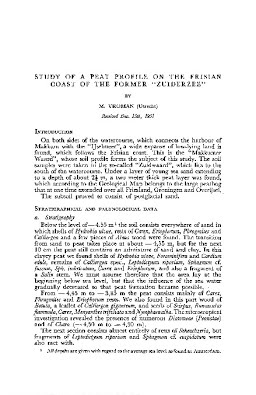1952
Study of a peat profile on the Frisian Coast of the former “Zuiderzee”
Publication
Publication
Mededelingen van het Botanisch Museum en Herbarium van de Rijksuniversiteit te Utrecht , Volume 111 - Issue 1 p. 250- 258
The subject of this study are soil samples taken in the “Makkumer Waard”, a wide expanse of low-lying land, which follows the Frisian coast. Stratigraphical and palynological investigations showed that in the beginning of the Atlanticum the area lay below the level of the sea, but that gradually the influence of the sea decreased and peat formation became possible. From the transition from marine deposits to Sphagnum peat (— 4,55 m to — 3,50 m) we must conclude that there has been a temporary standstill in the transgression, or even a regression, in the middle of the Atlanticum. Towards the end of the Atlantic period a sudden marine transgression followed, which deposited a layer of sand and clay on the Sphagnum peat (— 3,50 m to — 3,30 m). Shortly before the beginning of the Subboreal (which probably sets in at — 3,10 m) an important regression began and an Eriophorum peat was formed directly on the clay (—3,30 m to —3.00 m). It is probable that the peat formation went on in the Subatlanticum, but the younger Sphagnum peat is no longer present, for a third marine transgression, which lead to the formation of the “Zuiderzee”, washed away the peat and deposited the younger sea sand. The data obtained from the Makkum profile proved to agree very well with the results of other investigators who worked in the area round the North-sea.
| Additional Metadata | |
|---|---|
| Mededelingen van het Botanisch Museum en Herbarium van de Rijksuniversiteit te Utrecht | |
| Released under the CC-BY 4.0 ("Attribution") License | |
| Organisation | Naturalis journals & series |
|
Vroman, M. (1952). Study of a peat profile on the Frisian Coast of the former “Zuiderzee”. Mededelingen van het Botanisch Museum en Herbarium van de Rijksuniversiteit te Utrecht, 111(1), 250–258. |
|
